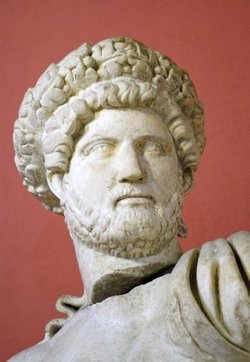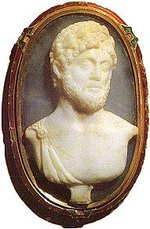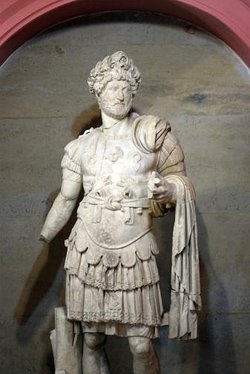Hadrian
|
|
Publius Aelius Traianus Hadrianus (January 24, 76 - July 10, 138), known as Hadrian in English, was Roman emperor from 117 - 138, and member of the gens Aelia.
Hadrian was born in Italica, Hispania, to a well-established settler family. He was a distant relative of his predecessor Trajan. Trajan never officially designated a successor, but, according to his wife, Trajan named Hadrian emperor immediately before his death. However, Trajan's wife was well-disposed toward Hadrian, and he may well have owed his succession to her.
| Contents |
Early life
Hadrian was born in Italica, Hispania, son of the prominent Baetican Publius Hadrianus Afer. Afer died when Hadrian was age 14 or so. Hadrian was schooled in various subjects particular to young aristocrats of the day, and was so fond of learning Greek literature that he was nicknamed "Graeculus" ("Little Greek").
Hadrian invested into the army sometime in the reign of Domitian. His first service was as a tribune of the Legio II Adiutrix. Later, he was to be transferred to the I Minervia in Germany. When Nerva died in 98, Hadrian rushed to inform Trajan personally. He later became legate of a legion in Upper Pannonia and eventually governor of said province. He was also archon in Athens for a brief time, and was elected an Athenian citizen.
Hadrian was active in the wars against the Dacians (as legate of the V Macedonica) and reputedly won awards from Trajan for his successes. Due to an absence of military action in his reign, Hadrian's military skill is not well attested, however his keen interest and knowledge of the army and his demonstrated skill of administration show possible strategic talent.
Hadrian and his legion remained in Syria to guard the Roman rear when Trajan pulled out of Parthia in 117 and died in Selinus. Hadrian was acclaimed Emperor by the senate when possibly falsified papers of adoption from Trajan were presented. Nevertheless, this rumor of a falsified document of adoption carried little weight. The real source of Hadrian's legitimacy arose from the endorsement of the armies of Syria and the senate ratification. It is speculated that Plotina, Trajan's empress (who favoured Hadrian) forged the papers.
Hadrian and the military
Despite his own excellence as a military administrator, Hadrian's reign was marked by a general lack of major military conflicts. He surrendered Trajan's conquests in Mesopotamia, considering them to be indefensible. There was almost a war with Parthia around 121, but the threat was averted when Hadrian succeeded in negotiating a peace. Hadrian's army crushed a massive Jewish uprising in Judea (132-135) led by Bar Kokhba, as well as the resistance to Roman rule by guerillas in Persia.
The peace policy was strengthened by the erection of permanent fortifications along the empire's borders (limites, sl. limes). The most famous of these is the massive Hadrian's Wall in Britain, and the Danube and Rhine borders were strengthened with a series of mostly wooden fortifications, forts, outposts and watchtowers, the latter specifically improving communications and local area security. To maintain morale and keep the troops from getting restive, Hadrian established intensive drill routines, and personally inspected the armies.
Cultural pursuits and patronage
Above all Hadrian patronized the arts: Hadrian's Villa at Tibur (Tivoli) was the greatest Roman example of an Alexandrian garden, recreating a sacred landscape, lost now in large part to the despoliation of the ruins by the Cardinal d'Este who had much of the marble removed to build his gardens. In Rome, the Pantheon built by Agrippa was enriched under Hadrian and took the form in which it remains to this day.
Hadrian was a humanist and deeply Hellenophile in all his tastes. While visiting Greece in 125 he attempted to create a kind of provincial parliament to bind all the semi-autonomous former city states across all Greece and Ionia (in Asia Minor). This parliament, known as the Panhellenion failed despite spirited efforts to instill cooperation among the Hellenes. Hadrian was especially famous for his love affair with a young Greek boy, Antinous. While touring Egypt, Antinous mysteriously drowned in the Nile in 130. Stricken with grief, Hadrian founded the Egyptian city of Antinopolis. Hadrian drew the whole Empire into his mourning, making Antinous the last new god of antiquity. For the rest of his life, Hadrian commissioned many hundreds (or thousands) of sculptures of Antinous in the manner of a Greek youth.
Hadrian died at his villa in Baiae. He was buried in a mausoleum on the western bank of Tiber, in Rome, a builduing later transformed into a fortress, Castel Sant'Angelo.
A fragment from the Roman History of Dio Cassius as translated by Earnest Cary in 1925:
- "After Hadrian's death there was erected to him a huge equestrian statue representing him with a four-horse chariot. It was so large that the bulkiest man could walk through the eye of each horse, yet because of the extreme height of the foundation persons passing along on the ground below believe that the horses themselves as well as Hadrian are very small."
External Link
- Historia Augusta: Life of Hadrian (http://penelope.uchicago.edu/Thayer/E/Roman/Texts/Historia_Augusta/Hadrian/1*.html)
- Hadian coinage (http://www.wildwinds.com/coins/ric/hadrian/t.html)
| Preceded by: Trajan | Roman Emperor 117–138 | Succeeded by: Antoninus Pius |



